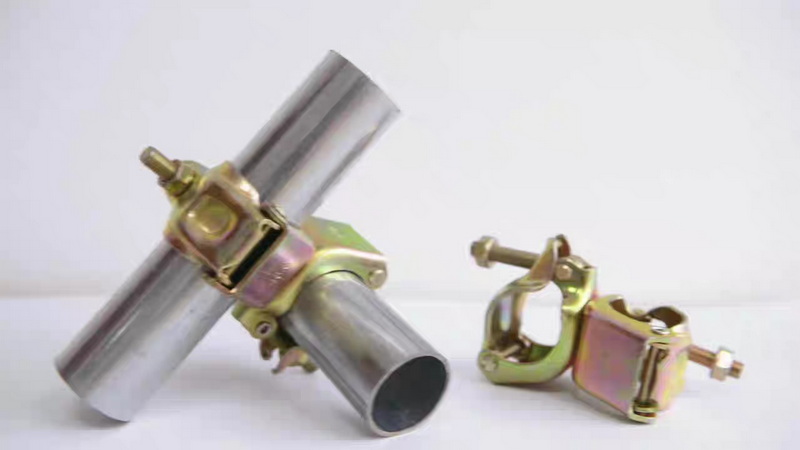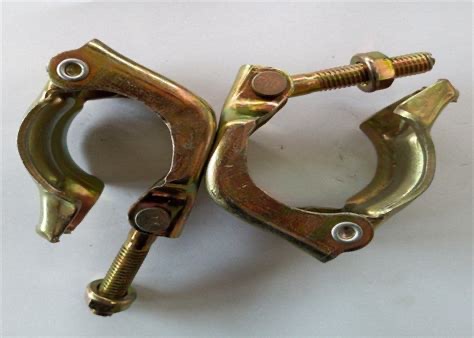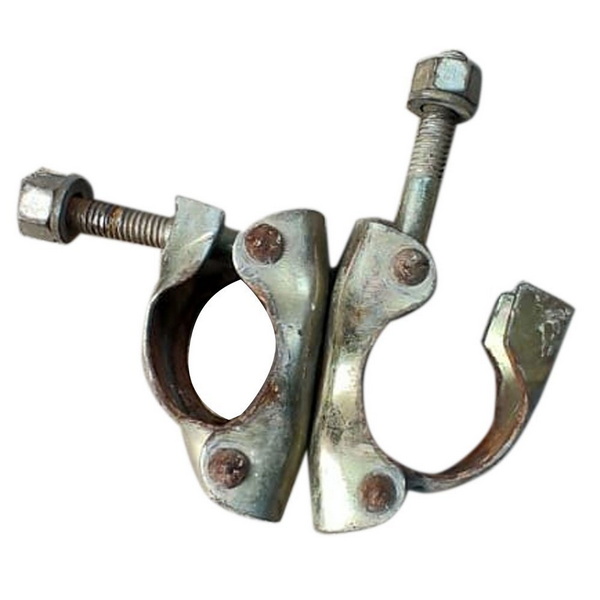Content Menu
● What Are Scaffolding Joint Clamps?
● Common Tube Sizes in Scaffolding
● Are Scaffolding Joint Clamps Universal?
>> No, Scaffolding Joint Clamps Are Not Universal for All Tube Sizes
>> Why Clamps Are Size-Specific
● Types of Scaffolding Joint Clamps and Their Size Compatibility
● Industry Standards and Specifications
>> EN 74 and BS 1139
>> OSHA and ANSI
● Practical Examples of Clamp and Tube Compatibility
● Tips for Selecting the Correct Scaffolding Joint Clamp
● Consequences of Using Incorrect Clamp Sizes
● Innovations and Adaptations in Scaffolding Clamps
● Additional Considerations: Wall Thickness and Tube Material
● Maintenance and Inspection of Scaffolding Clamps
● Conclusion
● FAQ
>> 1. Are scaffolding joint clamps interchangeable between different tube sizes?
>> 2. What is the most common tube size for scaffolding clamps?
>> 3. Can adjustable clamps fit multiple tube sizes?
>> 4. What happens if I use the wrong clamp size on a tube?
>> 5. How do I ensure my clamps and tubes are compatible?
Scaffolding joint clamps are fundamental components in tube and clamp scaffolding systems, providing the essential connections between tubes to create safe and stable structures. A common question in the construction and scaffolding industry is whether scaffolding joint clamps are universal and can fit all tube sizes. This article delves into the types, sizes, compatibility, standards, and practical considerations of scaffolding joint clamps.

What Are Scaffolding Joint Clamps?
Scaffolding joint clamps, also known as couplers, are mechanical devices used to connect scaffolding tubes at various angles and configurations. They hold the tubes securely in place, ensuring the structural integrity of the scaffold.
- Types: Include right-angle (fixed) clamps, swivel clamps, sleeve clamps, and beam clamps.
- Materials: Usually forged steel or pressed steel, often hot-dip galvanized or zinc plated for corrosion resistance.
- Function: Join tubes end-to-end, at right angles, or at variable angles depending on the clamp type.
Common Tube Sizes in Scaffolding
Scaffold tubes come in various diameters, with the most common sizes being:
- 48.3 mm (1.9 inches): The industry standard for tube and clamp scaffolding worldwide.
- 42.7 mm: Often used in traditional frame scaffolding systems.
- 60 mm and 76 mm: Used in heavy-duty shoring, props, and specialized scaffolding.
- 89 mm: Typically for larger structural supports such as bridge posts.
The outer diameter (OD) is critical because clamps must fit snugly around the tubes to ensure safety and load-bearing capacity.
Are Scaffolding Joint Clamps Universal?
No, Scaffolding Joint Clamps Are Not Universal for All Tube Sizes
Most scaffolding joint clamps are designed to fit specific tube diameters. For example:
- Clamps designed for 48.3 mm tubes will not securely fit 42.7 mm or 60 mm tubes.
- Using clamps on incompatible tube sizes can lead to unsafe connections and scaffold failure.
Why Clamps Are Size-Specific
- Safety: Proper fit is essential to prevent slippage or joint failure.
- Load Capacity: Clamps designed for a specific tube size optimize load distribution.
- Standards Compliance: Clamps must meet standards such as EN 74, BS 1139, OSHA, and ANSI, which specify tube and clamp compatibility.
Types of Scaffolding Joint Clamps and Their Size Compatibility
| Clamp Type | Typical Tube Size Compatibility (OD) | Description |
| Right-Angle (Fixed) | 42.7 mm, 48.3 mm, 60 mm, 76 mm | Connect tubes at 90 degrees, most common clamp. |
| Swivel Clamp | 42.7 mm, 48.3 mm, 60 mm, 76 mm | Connect tubes at any angle, flexible connections. |
| Sleeve Clamp | 48.3 mm, 60 mm | Join tubes end-to-end for length extension. |
| Beam Clamp | 48.3 mm, 60 mm | Attach scaffold tubes to beams or structures. |
Industry Standards and Specifications
EN 74 and BS 1139
- These European standards specify dimensions, materials, and testing procedures for scaffolding clamps and tubes.
- Clamps must fit tubes with specified outer diameters and wall thicknesses.
- Load capacities are tested with clamps matched to the correct tube sizes.
OSHA and ANSI
- U.S. regulations require scaffolding components to meet strict safety and compatibility standards.
- Using clamps with incompatible tube sizes violates these standards and risks scaffold failure.

Practical Examples of Clamp and Tube Compatibility
- 48.3 mm Tube with 48.3 mm Clamp: Standard and safest pairing.
- 42.7 mm Tube with 42.7 mm Clamp: Common in traditional frame scaffolding.
- 48.3 mm Clamp on 42.7 mm Tube: Unsafe due to loose fit, not recommended.
- 60 mm Clamp on 48.3 mm Tube: Not compatible; clamp too large.
Tips for Selecting the Correct Scaffolding Joint Clamp
1. Measure Tube Diameter Accurately: Use calipers to measure the outer diameter of tubes.
2. Check Clamp Specifications: Confirm clamp size matches tube diameter.
3. Use Certified Clamps: Ensure clamps meet EN 74 or equivalent standards.
4. Avoid Mixing Sizes: Do not use clamps designed for one tube size on a different size.
5. Consult Manufacturer Guidelines: Follow product manuals and safety instructions.
Consequences of Using Incorrect Clamp Sizes
- Structural Instability: Loose clamps can cause scaffold collapse.
- Reduced Load Capacity: Improper fit compromises load distribution.
- Safety Hazards: Increased risk of accidents and injuries.
- Non-Compliance: Violates safety regulations, leading to legal penalties.
Innovations and Adaptations in Scaffolding Clamps
Some manufacturers offer adjustable or universal clamps designed to accommodate a range of tube sizes. However, these are specialized products and must be certified for safety.
Additional Considerations: Wall Thickness and Tube Material
While outer diameter is the primary factor for clamp compatibility, wall thickness and tube material also influence the overall scaffold strength and clamp performance.
- Wall Thickness: Typical scaffold tubes have wall thicknesses of 3.2 mm to 4.0 mm. Thicker walls provide higher load capacity.
- Material: Most scaffolding tubes are made of steel, but aluminum tubes are also used for lightweight scaffolding. Clamps must be compatible with the tube material to avoid galvanic corrosion.
Maintenance and Inspection of Scaffolding Clamps
Regular inspection and maintenance are critical to scaffold safety.
- Check for Wear and Deformation: Clamps should be free of cracks, bends, or corrosion.
- Ensure Proper Tightening: Loose clamps reduce scaffold stability.
- Replace Damaged Clamps: Never use compromised clamps.
- Lubricate Threads: Prevents seizing and eases assembly/disassembly.
Conclusion
Scaffolding joint clamps are not universal for all tube sizes. It is crucial to match clamps with the correct tube diameter to ensure scaffold stability, safety, and compliance with industry standards. Using the right clamp for the right tube size maintains the structural integrity of scaffolding systems and protects workers from accidents. Always verify tube and clamp sizes before assembly and adhere to manufacturer and regulatory guidelines.

FAQ
1. Are scaffolding joint clamps interchangeable between different tube sizes?
No, clamps are designed for specific tube diameters and should not be interchanged to maintain safety.
2. What is the most common tube size for scaffolding clamps?
The most common tube size is 48.3 mm (1.9 inches), and clamps are widely manufactured for this size.
3. Can adjustable clamps fit multiple tube sizes?
Some adjustable clamps exist but must be certified for safety and used according to manufacturer instructions.
4. What happens if I use the wrong clamp size on a tube?
Using the wrong size can cause loose joints, scaffold instability, and potential collapse.
5. How do I ensure my clamps and tubes are compatible?
Measure tube diameters accurately and purchase clamps specified for those sizes from reputable manufacturers.






















